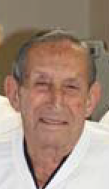Thanks for the Memories

Hundreds paid their respects last week to Jack Gelrud, who died Feb. 23, 2012 at the age of 89. He was among the early entrepreneurs who turned Lexington Park from a boom town into a hometown.
His long and active life included health and success; loss and love; a wonderful family; and a tremendous circle of friends. Days before his death, he’d written down some thoughts on these topics and handed the slip of paper to one of his sons.
“What is this, Dad?”
“Just take it,” Jack Gelrud had told his son. “You’ll know what to do with it.”
He read his father’s blessings for health and wealth, fruitfulness and love at his father’s packed funeral service. Among all these blessings, concluded the note his father had placed into his son’s hand, the most important is friendship.
Jack Gelrud began making friends in Lexington Park in 1948, choosing a rural locale to open Park Rexall Pharmacy on Coral Drive.
Likely every friend Jack Gelrud made before and since – and there have been thousands – knew him to be a master storyteller. Among the legacies he leaves Southern Maryland are oral histories he contributed in 1998 to the SlackWater archive at St. Mary’s College of Maryland.
Mr. Gelrud’s stories of serving as a medic in World War II and of the formative years of Lexington Park are recorded, compiled and transcribed as a part of the Cedar Point Project of the archive. Marc Kriss interviewed Mr. Gelrud in 1998 for both “The Overseas Experience in World War II” and “Lexington Park and the People Who Have Influenced It” projects. Some excerpts about Mr.Gelrud’s arrival in Lexington Park appear below.
“. . . this was as rural as we could find at the time. And it was a very, very interesting area in that it was a population of 39,000 people. It had one drugstore in Lexington Park and one drugstore in Leonardtown; a total of three drugstores in all of St. Mary’s County.”
“After we opened in 1948-1949, that area was still a trailer park and a ball field, over in the back of [the Gymnastic Center in Millison Plaza]. There was so much open ground. The only homes around were the Flat-Tops and the homes in Patuxent Park. There was nothing on that highway. From the road down to Great Mills there was nothing. A drive-in to get ice cream, something like that, a few bars, no homes, no businesses.
“. . .when we had two drugstores growing in the county we hired forty people, we were considered a large employer at that time. From 1955 on, we had two stores, but as the area grew forty employees was nothing because these big companies came in. . .”
“Then the other businesses opened up more on Great Mills Road, from Lexington Park to the Great Mills Road area, and that’s where everything happened, within a three block area in Lexington Park, within walking distance of the gate because that was the ideal place to do it.”
“The Millisons probably made the largest investment in the Lexington Park area of anyone else. [Another person who] made a big investment in that area was Robert Gabrelcik. . . [T]here was a cleaners, a barber shop, a baby store, and a dress shop. That was it, and a movies was next door, and Pat’s Bar was on the corner. The Atwood Bus Station was across the street. The Atwood used to come in here, and the Greyhound came in here on a daily basis. . . .On the other side of town there was a pharmacy, and a Ben Franklin store, and a couple other stores. And that was it for the whole town.”
” There were relatively few stores and the area where [Big Lots] is, back in that whole area, it was a trailer park and a baseball field. And there were no stores back there at all. The post office was not where it was, it was in another place. And it was a muddy street out in front of the store. It was a cow town so to speak . . .”
” It was a one-lane road from Waldorf in, and it was the same thing. Just a two-lane highway until Upper Marlboro and Baltimore. So you can see how far this has come. When Sue and I were married in 1969, there was one traffic light in Lexington Park, and that was at the main gate. Now there’s what? How many? I can’t count them anymore.”
“And it goes all the way back to the first test pilot I ever knew down here, was a Lieutenant Colonel North, who was top test pilot on the base in 1948-1949. All these guys were very famous people. Dick Scott was former all-American center from Navy, was stationed down there, football player. Colonel [John] Glenn was here. Shepherd, Carpenter, all customers, and just down-to-earth people. And that’s the great thing about it: all the people that contributed are just normal people with a wish to see the area grow and develop.”
Thanks for the memories, Jack.























